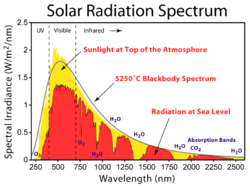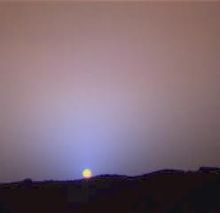
Sunlight
About this schools Wikipedia selection
This selection is made for schools by a children's charity read more. Click here to find out about child sponsorship.

Sunlight is a portion of the electromagnetic radiation given off by the Sun, particularly infrared, visible, and ultraviolet light. On Earth, sunlight is filtered through the Earth's atmosphere, and is obvious as daylight when the Sun is above the horizon.
When the direct solar radiation is not blocked by clouds, it is experienced as sunshine, a combination of bright light and radiant heat. When it is blocked by the clouds or reflects off other objects, it is experienced as diffused light.
The World Meteorological Organization uses the term "sunshine duration" to mean the cumulative time during which an area receives direct irradiance from the Sun of at least 120 watts per square meter.
Sunlight may be recorded using a sunshine recorder, pyranometer or pyrheliometer.
Sunlight takes about 8.3 minutes to reach the Earth. On average, it takes energy between 10,000 and 170,000 years to leave the sun's interior and then be emitted from the surface as light.
Direct sunlight has a luminous efficacy of about 93 lumens per watt of radiant flux. Bright sunlight provides illuminance of approximately 100,000 lux or lumens per square meter at the Earth's surface. The total amount of energy received at ground level from the sun at the zenith is 1004 watts per square meter, which is composed of 527 watts of infrared radiation, 445 watts of visible light, and 32 watts of ultraviolet radiation. At the top of the atmosphere sunlight is about 30% more intense, with more than three times the fraction of ultraviolet (UV), with most of the extra UV consisting of biologically-damaging shortwave ultraviolet.
Sunlight is a key factor in photosynthesis, a process vital for many living beings on Earth.
Composition and power
The spectrum of the Sun's solar radiation is close to that of a black body with a temperature of about 5,800 K. The Sun emits EM radiation across most of the electromagnetic spectrum. Although the Sun produces Gamma rays as a result of the nuclear fusion process, these super high energy photons are converted to lower energy photons before they reach the Sun's surface and are emitted out into space. As a result, the Sun does not emit gamma rays. The Sun does, however, emit X-rays, ultraviolet, visible light, infrared, and even radio waves.
Although, as mentioned, the solar corona is a source of extreme ultraviolet and X-ray radiation, these rays make up only a very small amount of the power output of the Sun (see spectrum at right) and will not be discussed further. The spectrum of nearly all solar electromagnetic radiation striking the Earth's atmosphere spans a range of 100 nm to about 1 mm. This band of significant radiation power can be divided into five regions in increasing order of wavelengths:
- Ultraviolet C or (UVC) range, which spans a range of 100 to 280 nm. The term ultraviolet refers to the fact that the radiation is at higher frequency than violet light (and, hence also invisible to the human eye). Owing to absorption by the atmosphere very little reaches the Earth's surface. This spectrum of radiation has has germicidal properties, and is used in germicidal lamps.
- Ultraviolet B or (UVB) range spans 280 to 315 nm. It is also greatly absorbed by the atmosphere, and along with UVC is responsible for the photochemical reaction leading to the production of the ozone layer. It directly damages DNA and causes sunburn.
- Ultraviolet A or (UVA) spans 315 to 400 nm. This band was once held to be less damaging to DNA, and hence is used in cosmetic artificial sun tanning ( tanning booths and tanning beds) and PUVA therapy for psoriasis. However, UV A is now known to cause significant damage to DNA via indirect routes (formation of free radicals and reactive oxygen species), and is able to cause cancer.
- Visible range or light spans 380 to 780 nm. As the name suggests, it is this range that is visible to the naked eye.
- Infrared range that spans 700 nm to 106 nm (1 mm). It is responsible for an important part of the electromagnetic radiation that reaches the Earth. It is also divided into three types on the basis of wavelength:
- Infrared-A: 700 nm to 1,400 nm
- Infrared-B: 1,400 nm to 3,000 nm
- Infrared-C: 3,000 nm to 1 mm.
Sunlight in space at the top of Earth's atmosphere at a power of 1366 watts/m2 is composed (by total energy) of about 50% infrared light, 40% visible light, and 10% ultraviolet light. At ground level this decreases to about 1120–1000 watts/m2, and by energy fractions to 44% visible light, 3% ultraviolet (with the Sun at the zenith, but less at other angles), and the remainder infrared. Thus, sunlight's composition at ground level, per square meter, with the sun at the zenith, is about 527 watts of infrared radiation, 445 watts of visible light, and 32 watts of ultraviolet radiation.
Calculation
To calculate the amount of sunlight reaching the ground, both the elliptical orbit of the Earth and the attenuation by the Earth's atmosphere have to be taken into account. The extraterrestrial solar illuminance (Eext), corrected for the elliptical orbit by using the day number of the year (dn), is given by
where dn=1 on January 1; dn=2 on January 2; dn=32 on February 1, etc. In this formula dn-3 is used, because in modern times Earth's perihelion, the closest approach to the Sun and therefore the maximum Eext occurs around January 3 each year. The value of 0.033412 is determined knowing that the ratio between the perihelion (0.98328989 AU) squared and the aphelion (1.01671033 AU) squared should be approximately 0.935338.
The solar illuminance constant (Esc), is equal to 128×103 lx. The direct normal illuminance (Edn), corrected for the attenuating effects of the atmosphere is given by:
where c is the atmospheric extinction coefficient and m is the relative optical airmass.
Solar constant
The solar constant, a measure of flux density, is the amount of incoming solar electromagnetic radiation per unit area that would be incident on a plane perpendicular to the rays, at a distance of one astronomical unit (AU) (roughly the mean distance from the Sun to the Earth). The "solar constant" includes all types of solar radiation, not just the visible light. Its average value was thought to be approximately 1.366 kW/m², varying slightly with solar activity, but recent recalibrations of the relevant satellite observations indicate a value closer to 1.361 kW/m² is more realistic. This radiation is about 50% infrared, 40% visible, and about 10% ultraviolet at the top of the atmosphere.
Total (TSI) and spectral solar irradiance (SSI) upon Earth
Total Solar Irradiance (TSI) – the amount of solar radiation received at the top of the Earth’s atmosphere – was earlier measured by satellite to be roughly 1.366 kilowatts per square meter (kW/m²), but most recently NASA cites TSI as 1361 W/m² as compared to ~1366 W/m² from earlier observations, based on results from a series of NASA and ESA satellite TSI monitors continuing today with the ACRIMSAT/ACRIM3, SOHO/VIRGO and SORCE/TIM observations. This “discovery is critical in examining the energy budget of the planet Earth and isolating the climate change due to human activities.” Furthermore the SORCE Spectral Irradiance Monitor (SIM) has found in the same period that spectral solar irradiance (SSI) at UV (ultraviolet) wavelength corresponds in a less clear, and probably more complicated fashion, with earth's climate responses than earlier assumed, fueling broad avenues of new research in “the connection of the Sun and stratosphere, troposphere, biosphere, ocean, and Earth’s climate”.
Intensity in the Solar System
Different bodies of the Solar System receive light of an intensity inversely proportional to the square of their distance from Sun. A rough table comparing the amount of solar radiation received by each planet in the Solar System follows (from data in ):
| Planet | distance ( AU) | Solar radiation (W/m²) | ||
|---|---|---|---|---|
| Perihelion | Aphelion | maximum | minimum | |
| Mercury | 0.3075 | 0.4667 | 14,446 | 6,272 |
| Venus | 0.7184 | 0.7282 | 2,647 | 2,576 |
| Earth | 0.9833 | 1.017 | 1,413 | 1,321 |
| Mars | 1.382 | 1.666 | 715 | 492 |
| Jupiter | 4.950 | 5.458 | 55.8 | 45.9 |
| Saturn | 9.048 | 10.12 | 16.7 | 13.4 |
| Uranus | 18.38 | 20.08 | 4.04 | 3.39 |
| Neptune | 29.77 | 30.44 | 1.54 | 1.47 |
The actual brightness of sunlight that would be observed at the surface depends also on the presence and composition of an atmosphere. For example Venus' thick atmosphere reflects more than 60% of the solar light it receives. The actual illumination of the surface is about 14,000 lux, comparable to that on Earth "in the daytime with overcast clouds".
Sunlight on Mars would be more or less like daylight on Earth wearing sunglasses, and as can be seen in the pictures taken by the rovers, there is enough diffuse sky radiation that shadows would not seem particularly dark. Thus it would give perceptions and "feel" very much like Earth daylight.
For comparison purposes, sunlight on Saturn is slightly brighter than Earth sunlight at the average sunset or sunrise (see daylight for comparison table). Even on Pluto the sunlight would still be bright enough to almost match the average living room. To see sunlight as dim as full moonlight on the Earth, a distance of about 500 AU (~69 light-hours) is needed; there are only a handful of objects in the solar system known to orbit farther than such a distance, among them 90377 Sedna and (87269) 2000 OO67.
Surface illumination
The spectrum of surface illumination depends upon solar elevation due to atmospheric effects, with the blue spectral component from atmospheric scatter dominating during twilight before and after sunrise and sunset, respectively, and red dominating during sunrise and sunset. These effects are apparent in natural light photography where the principal source of illumination is sunlight as mediated by the atmosphere.
According to Craig Bohren, "preferential absorption of sunlight by ozone over long horizon paths gives the zenith sky its blueness when the sun is near the horizon".
See diffuse sky radiation for more details.
Climate effects
On Earth, solar radiation is obvious as daylight when the sun is above the horizon. This is during daytime, and also in summer near the poles at night, but not at all in winter near the poles. When the direct radiation is not blocked by clouds, it is experienced as sunshine, combining the perception of bright white light (sunlight in the strict sense) and warming. The warming on the body, the ground and other objects depends on the absorption (electromagnetic radiation) of the electromagnetic radiation in the form of heat.
The amount of radiation intercepted by a planetary body varies inversely with the square of the distance between the star and the planet. The Earth's orbit and obliquity change with time (over thousands of years), sometimes forming a nearly perfect circle, and at other times stretching out to an orbital eccentricity of 5% (currently 1.67%). The total insolation remains almost constant due to Kepler's second law,
where  is the "areal velocity" invariant. That is, the integration over the orbital period (also invariant) is a constant.
is the "areal velocity" invariant. That is, the integration over the orbital period (also invariant) is a constant.
If we assume the solar radiation power P as a constant over time and the solar irradiation given by the inverse-square law, we obtain also the average insolation as a constant.
But the seasonal and latitudinal distribution and intensity of solar radiation received at the Earth's surface also varies. For example, at latitudes of 65 degrees the change in solar energy in summer and winter can vary by more than 25% as a result of the Earth's orbital variation. Because changes in winter and summer tend to offset, the change in the annual average insolation at any given location is near zero, but the redistribution of energy between summer and winter does strongly affect the intensity of seasonal cycles. Such changes associated with the redistribution of solar energy are considered a likely cause for the coming and going of recent ice ages (see: Milankovitch cycles).
Past variations in solar irradiance
Space-based observations of solar irradiance started in 1978. These measurements show that the solar constant is not constant. It varies with the 11-year sunspot solar cycle. When going further back in time, one has to rely on irradiance reconstructions, using sunspots for the past 400 years or cosmogenic radionuclides for going back 10,000 years. Such reconstructions have been done. These studies show that solar irradiance does vary with distinct periodicities such as: 11 years (Schwabe), 88 years (Gleisberg cycle), 208 years (DeVries cycle) and 1,000 years (Eddy cycle).
Life on Earth
The existence of nearly all life on Earth is fueled by light from the sun. Most autotrophs, such as plants, use the energy of sunlight, combined with carbon dioxide and water, to produce simple sugars—a process known as photosynthesis. These sugars are then used as building blocks and in other synthetic pathways which allow the organism to grow.
Heterotrophs, such as animals, use light from the sun indirectly by consuming the products of autotrophs, either by consuming autotrophs, by consuming their products or by consuming other heterotrophs. The sugars and other molecular components produced by the autotrophs are then broken down, releasing stored solar energy, and giving the heterotroph the energy required for survival. This process is known as cellular respiration.
In prehistory, humans began to further extend this process by putting plant and animal materials to other uses. They used animal skins for warmth, for example, or wooden weapons to hunt. These skills allowed humans to harvest more of the sunlight than was possible through glycolysis alone, and human population began to grow.
During the Neolithic Revolution, the domestication of plants and animals further increased human access to solar energy. Fields devoted to crops were enriched by inedible plant matter, providing sugars and nutrients for future harvests. Animals which had previously only provided humans with meat and tools once they were killed were now used for labour throughout their lives, fueled by grasses inedible to humans.
The more recent discoveries of coal, petroleum and natural gas are modern extensions of this trend. These fossil fuels are the remnants of ancient plant and animal matter, formed using energy from sunlight and then trapped within the earth for millions of years. Because the stored energy in these fossil fuels has accumulated over many millions of years, they have allowed modern humans to massively increase the production and consumption of primary energy. As the amount of fossil fuel is large but finite, this cannot continue indefinitely, and various theories exist as to what will follow this stage of human civilization (e.g. alternative fuels, Malthusian catastrophe, new urbanism, peak oil).
Cultural aspects

The effect of sunlight is relevant to painting, evidenced for instance in works of Claude Monet on outdoor scenes and landscapes.
Many people find direct sunlight to be too bright for comfort, especially when reading from white paper upon which the sun is directly shining. Indeed, looking directly at the sun can cause long-term vision damage. To compensate for the brightness of sunlight, many people wear sunglasses. Cars, many helmets and caps are equipped with visors to block the sun from direct vision when the sun is at a low angle. Sunshine is often blocked from entering buildings through the use of walls, window blinds, awnings, shutters or curtains, or by nearby shade trees.
In colder countries, many people prefer sunnier days and often avoid the shade. In hotter countries the converse is true; during the midday hours many people prefer to stay inside to remain cool. If they do go outside, they seek shade which may be provided by trees, parasols, and so on.
In Hinduism the sun is considered to be a god as it is the source of life and energy on earth.
Sunbathing
Sunbathing is a popular leisure activity in which a person sits or lies in direct sunshine. People often sunbathe in comfortable places where there is ample sunlight. Some common places for sunbathing include beaches, open air swimming pools, parks, gardens, and sidewalk cafés. Sunbathers typically wear limited amounts of clothing or some simply go nude. For some, an alternative to sunbathing is the use of a sunbed that generates ultraviolet light and can be used indoors regardless of outdoor weather conditions and amount of sunlight.
For many people with pale or brownish skin, one purpose for sunbathing is to darken one's skin colour (get a sun tan) as this is considered in some cultures to be beautiful, associated with outdoor activity, vacations/holidays, and health. Some people prefer naked sunbathing so that an "all-over" or "even" tan can be obtained, sometimes as part of a specific lifestyle.
For people suffering from psoriasis, sunbathing is an effective way of healing the symptoms.
Skin tanning is achieved by an increase in the dark pigment inside skin cells called melanocytes and it is actually an automatic response mechanism of the body to sufficient exposure to ultraviolet radiation from the sun or from artificial sunlamps. Thus, the tan gradually disappears with time, when one is no longer exposed to these sources.
Effects on human health
The body produces vitamin D from sunlight (specifically from the UVB band of ultraviolet light), and excessive seclusion from the sun can lead to deficiency unless adequate amounts are obtained through diet.
Sunburn can have mild to severe inflammation effects on skin; this can be avoided by using a proper sunscreen cream or lotion or by gradually building up melanocytes with increasing exposure. Another detrimental effect of UV exposure is accelerated skin aging (also called skin photodamage), which produces a difficult to treat cosmetic effect. Some people are concerned that ozone depletion is increasing the incidence of such health hazards. A 10% decrease in ozone could cause a 25% increase in skin cancer.
A lack of sunlight, on the other hand, is considered one of the primary causes of seasonal affective disorder (SAD), a serious form of the "winter blues". SAD occurrence is more prevalent in locations further from the tropics, and most of the treatments (other than prescription drugs) involve light therapy, replicating sunlight via lamps tuned to specific wavelengths of visible light, or full-spectrum bulbs.
A recent study indicates that more exposure to sunshine early in a person’s life relates to less risk from multiple sclerosis (MS) later in life.






